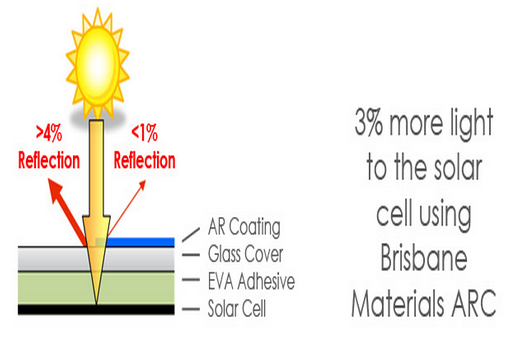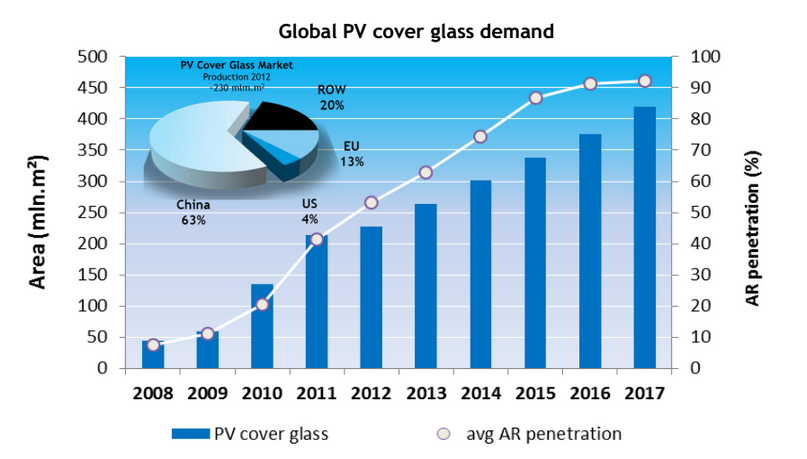With anti-reflection coatings on module glass promising gains of up to 3% or more in module efficiency, the glass industry is predicting an increasing uptake (PDF) of anti-reflection coating among PV module manufacturers.
While the quest to improve cell technology has received a lot of attention and R&D dollars, losses at the module level have largely been ignored by the PV industry. One such overlooked aspect is the glass covering on PV modules.
Glass currently accounts for 8-10% of the cost of a crystalline silicon PV module and is one of the 2 most important optical components in a module. It is the first layer that sunlight has to pass through to reach the cell, which is the actual power-generating component. While most solar glass is highly transparent and lets in 94% of the sun’s light through, the remaining 6% of the light is either absorbed within the glass (2%) or is reflected back (4%).
 Top photo source: Brisbane Materials Technology
Top photo source: Brisbane Materials Technology
Since reducing reflection loss is more easily done than increasing cell efficiency by the same amount, this approach represents the low hanging fruit in efficiency improvement.
There are currently two cost effective ways to reduce reflection: (a) by texturing the glass surface, and (b) adding an anti-reflection coating (ARC) on top of the glass surface.
Texturing reduces reflection by effectively randomizing the direction in which light is reflected off the glass surface. While this is beneficial, dirt can accumulate in the small ‘troughs’ or ‘valleys’ of the glass surface if not textured properly. This would block light and lead to more loss in efficiency than would be gained from the texturing, effectively defeating its purpose.
On the other hand, anti-reflection coatings can reduce reflection even on a smooth or planar glass surface. By carefully controlling the thickness and the optical properties of the coating, it is possible to reduce reflection from typical levels of 4-5% to less than 1%. This translates into a gain of 2-4% in Wp (watt-peak) terms, or an increase of >7 Wp for a 250 Wp module.
Hence, module manufacturers have taken to AR coated glass in a big way. As of 2013, over 60% of the glass used in PV applications was AR coated, with projections indicating increasing market penetration (PDF) of up to 75% in 2014.
Source: DSM
Glass ARCs for most industrial applications are typically deposited using vacuum-based processes like chemical vapour deposition (CVD); however, such methods tend to be expensive. Most glass for PV applications are instead coated using a cheaper ‘sol-gel’ process wherein a liquid layer is coated on top of the glass, then dried and cured at temperatures of up to 600 °C to produce a thin, solid film with micropores.
However, recent advances in sol-gel technology have eliminated the need for high temperature, making anti-reflection coating deposition at room temperatures a reality. Since lower temperatures require lower cost tools, this approach has a significant cost advantage and is being increasingly adopted by the industry. One such Australian outfit that has managed to adopt the low-temperature technology is Brisbane Materials Technology, a Brisbane-based specialty materials company.
By partnering with equipment manufacturer, EVG Group, Brisbane Materials Technology has successfully demonstrated a sol-gel based AR coating process that can be performed at room temperature and at atmospheric pressure. By leveraging the process simplicity, they expect to be able to offer some of the lowest costs per square metre of coated glass in the PV industry. In recognition of this, they were recently awarded a $1.3 million grant from the Australian Renewable Energy Agency (ARENA) to set up a pilot-line manufacturing facility in Darra, Queensland.
Riding on the back of such advances, sol-gel processing is expected to remain the predominant method for AR coating and already accounts for 96% of the coated solar glass market.
In addition to reducing reflection, AR coatings can also be engineered to be self-cleaning. This can be done by either making the coating extremely hydrophobic (i.e. repels water strongly, thereby allowing dirt and liquids to easily run off the glass surface before they can be lodged on the surface) or by making it hydrophilic (i.e. more wettable, thereby allowing rain water to carry away the dirt more effectively). Such anti-soiling technology is particularly important for solar farms and large-scale systems where cleaning/de-soiling modules can be a significant operation and maintenance (O&M) cost.
Given the multiple advantages of coated glass and the relatively low cost of efficiency improvement it offers, it’s easy to understand the increasing preference for coated glass technology in the PV. If projections hold true, most of the solar glass (over 90%) will become coated by 2017!
© 2014 Solar Choice Pty Ltd
- Future of Utilities – Part 1: The death of base-load generators - 11 September, 2014
- Sharp enters energy storage market with SmartStorage - 18 August, 2014
- Phinergy extends electric car range with metal-air battery technology - 13 August, 2014
